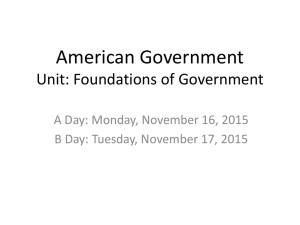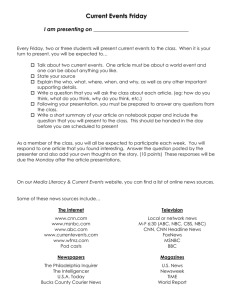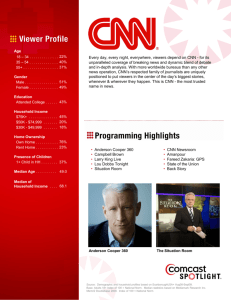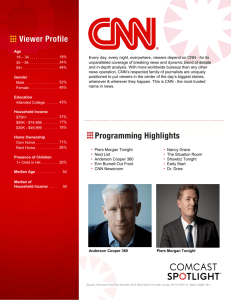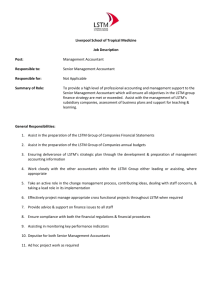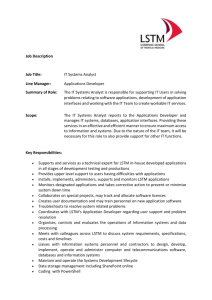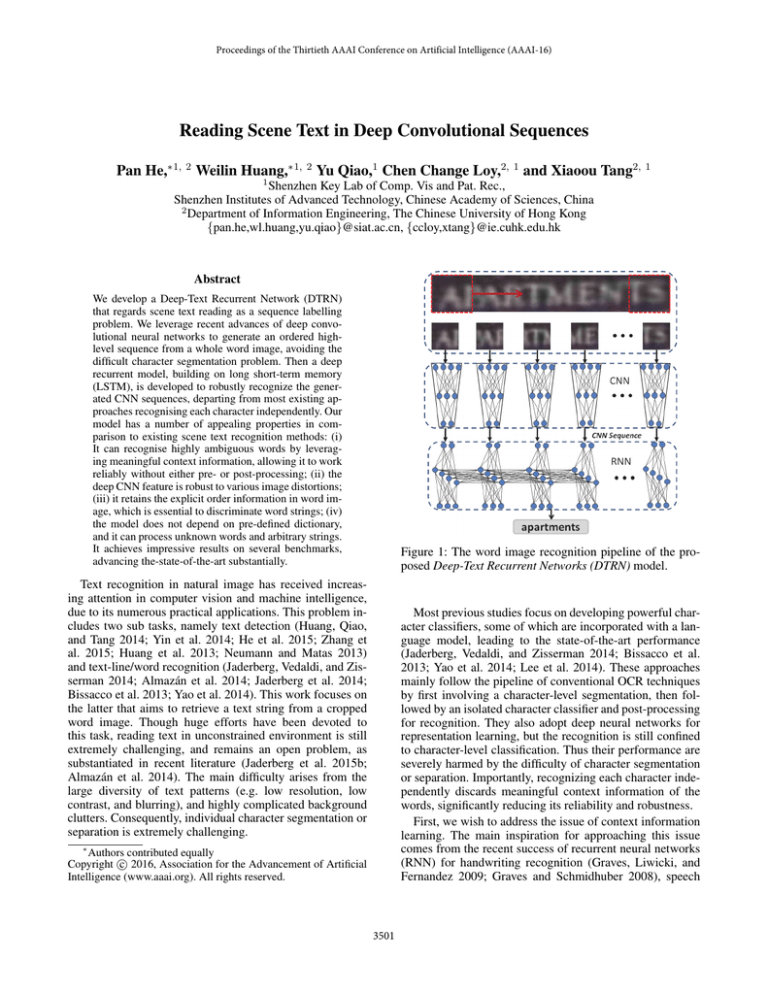
Proceedings of the Thirtieth AAAI Conference on Artificial Intelligence (AAAI-16)
Reading Scene Text in Deep Convolutional Sequences
Pan He,∗1, 2 Weilin Huang,∗1, 2 Yu Qiao,1 Chen Change Loy,2, 1 and Xiaoou Tang2, 1
1
Shenzhen Key Lab of Comp. Vis and Pat. Rec.,
Shenzhen Institutes of Advanced Technology, Chinese Academy of Sciences, China
2
Department of Information Engineering, The Chinese University of Hong Kong
{pan.he,wl.huang,yu.qiao}@siat.ac.cn, {ccloy,xtang}@ie.cuhk.edu.hk
Abstract
We develop a Deep-Text Recurrent Network (DTRN)
that regards scene text reading as a sequence labelling
problem. We leverage recent advances of deep convolutional neural networks to generate an ordered highlevel sequence from a whole word image, avoiding the
difficult character segmentation problem. Then a deep
recurrent model, building on long short-term memory
(LSTM), is developed to robustly recognize the generated CNN sequences, departing from most existing approaches recognising each character independently. Our
model has a number of appealing properties in comparison to existing scene text recognition methods: (i)
It can recognise highly ambiguous words by leveraging meaningful context information, allowing it to work
reliably without either pre- or post-processing; (ii) the
deep CNN feature is robust to various image distortions;
(iii) it retains the explicit order information in word image, which is essential to discriminate word strings; (iv)
the model does not depend on pre-defined dictionary,
and it can process unknown words and arbitrary strings.
It achieves impressive results on several benchmarks,
advancing the-state-of-the-art substantially.
Figure 1: The word image recognition pipeline of the proposed Deep-Text Recurrent Networks (DTRN) model.
Text recognition in natural image has received increasing attention in computer vision and machine intelligence,
due to its numerous practical applications. This problem includes two sub tasks, namely text detection (Huang, Qiao,
and Tang 2014; Yin et al. 2014; He et al. 2015; Zhang et
al. 2015; Huang et al. 2013; Neumann and Matas 2013)
and text-line/word recognition (Jaderberg, Vedaldi, and Zisserman 2014; Almazán et al. 2014; Jaderberg et al. 2014;
Bissacco et al. 2013; Yao et al. 2014). This work focuses on
the latter that aims to retrieve a text string from a cropped
word image. Though huge efforts have been devoted to
this task, reading text in unconstrained environment is still
extremely challenging, and remains an open problem, as
substantiated in recent literature (Jaderberg et al. 2015b;
Almazán et al. 2014). The main difficulty arises from the
large diversity of text patterns (e.g. low resolution, low
contrast, and blurring), and highly complicated background
clutters. Consequently, individual character segmentation or
separation is extremely challenging.
Most previous studies focus on developing powerful character classifiers, some of which are incorporated with a language model, leading to the state-of-the-art performance
(Jaderberg, Vedaldi, and Zisserman 2014; Bissacco et al.
2013; Yao et al. 2014; Lee et al. 2014). These approaches
mainly follow the pipeline of conventional OCR techniques
by first involving a character-level segmentation, then followed by an isolated character classifier and post-processing
for recognition. They also adopt deep neural networks for
representation learning, but the recognition is still confined
to character-level classification. Thus their performance are
severely harmed by the difficulty of character segmentation
or separation. Importantly, recognizing each character independently discards meaningful context information of the
words, significantly reducing its reliability and robustness.
First, we wish to address the issue of context information
learning. The main inspiration for approaching this issue
comes from the recent success of recurrent neural networks
(RNN) for handwriting recognition (Graves, Liwicki, and
Fernandez 2009; Graves and Schmidhuber 2008), speech
∗
Authors contributed equally
c 2016, Association for the Advancement of Artificial
Copyright Intelligence (www.aaai.org). All rights reserved.
3501
recognition (Graves and Jaitly 2014), and language translation (Sutskever, Vinyals, and Le 2014). We found the strong
capability of RNN in learning continuous sequential features
particularly well-suited for text recognition task to retain
the meaningful interdependencies of the continuous text sequence. We note that RNNs have been formulated for recognizing handwritten or documented images (Graves, Liwicki, and Fernandez 2009; Graves and Schmidhuber 2008;
Breuel et al. 2013), nevertheless, the background in these
tasks is relatively plain, and the raw image feature can be
directly input to RNN for recognition, or the text stroke information can be easily extracted or binarized at pixel level,
making it possible to manually design a sequential heuristic
feature for the input to RNN. In contrast, the scene text image is much more complicated where pixel-level segmentation is extremely difficult, especially for highly ambiguous
images (Fig. 1). Thus it is non-trivial to directly apply the
sequence labelling models to scene text.
Consequently, the second challenge we need to resolve is
the issue of character segmentation. We argue that individual character segmentation is not a ‘must’ in text recognition. The key is to acquire strong representation from the
image, with explicit order information. The strong representation ensures robustness to various distortions and background clutters, whilst the explicit order information is crucial to discriminate a meaningful word. The ordered strong
feature sequence computed from the sequential regions of
word image allows each frame region to locate the part of a
character, which can be stored sequentially by the recurrent
model. This makes it possible to recognize the character robustly by using its continuous parts, and thus successfully
avoid the character segmentation.
To this end, we develop a deep recurrent model that reads
word images in deep convolutional sequences. The new
model is referred as Deep-Text Recurrent Network (DTRN),
of which the pipeline is shown in Fig. 1. It takes both the advantages of the deep CNN for image representation learning
and the RNN model for sequence labelling, with the following appealing properties:
1) Strong and high-level representation without character segmentation – The DTRN generates a convolutional
image sequence, which is explicitly ordered by scanning a
sliding window through a word image. The CNN sequence
captures meaningful high-level representation that is robust
to various image distortions. It differs significantly from
manually-designed sequential features used by most prior
studies based on sequence labelling (Breuel et al. 2013;
Graves, Liwicki, and Fernandez 2009; Su and Lu 2014).
The sequence is generated without any low-level operation
or challenging character segmentation.
2) Exploiting context information In contrast to existing
systems (Bissacco et al. 2013; Jaderberg, Vedaldi, and Zisserman 2014; Wang et al. 2012) that read each character independently, we formulate this task as a sequence labelling
problem. Specifically, we build our system on the LSTM, so
as to capture the interdependencies inherent in the deep sequences. Such consideration allows our system to recognize
highly ambiguous words, and work reliably without either
pre- or post-processing. In addition, the recurrence allows it
to process sequences of various lengths, going beyond traditional neural networks of fixed-length input and output.
3) Process unknown words and arbitrary strings With
properly learned deep CNNs and RNNs, our model does not
depend on any pre-defined dictionary, unlike exiting studies (Jaderberg et al. 2015b; Jaderberg, Vedaldi, and Zisserman 2014; Wang et al. 2012), and it can process unknown
words, and arbitrary strings, including multiple words.
We note that CNN and RNN have been independently exploited in the domain of text recognition. Our main contribution in this study is to develop a unified deep recurrent system that leverages both the advantages of CNN and
RNN for the difficult scene text recognition problem, which
has been solved based on analyzing character independently.
This is the first attempt to show the effectiveness of exploiting convolutional sequence with sequence labeling model
for this challenging task. We highlight the considerations required to make this system reliable and discuss the unique
advantages offered by it. The proposed DTRN demonstrate
promising results on a number of benchmarks, improving
recent results of (Jaderberg, Vedaldi, and Zisserman 2014;
Almazán et al. 2014) considerably.
Related Work
Previous work mainly focuses on developing a powerful
character classifier with manually-designed image features.
A HoG feature with random ferns was developed for character classification in (Wang, Babenko, and Belongie 2011).
Neumann and Matas proposed new oriented strokes for
character detection and classification (Neumann and Matas
2013). Their performance is limited by the low-level features. In (Lee et al. 2014), a mid-level representation of
characters was developed by proposing a discriminative feature pooling. Similarly, Yao et al. proposed the mid-level
Strokelets to describe the parts of characters (Yao et al.
2014).
Recent advances of DNN for image representation encourage the development of more powerful character classifiers, leading to the state-of-the-art performance on this task.
The pioneer work was done by LeCun et al., who designed
a CNN for isolated handwriting digit recognition (LeCun et
al. 1998). A two-layer CNN system was proposed for both
character detection and classification in (Wang et al. 2012).
PhotoOCR system employs a five-layer DNN for character
recognition (Bissacco et al. 2013). Similarly, Jaderberg et
al. (Jaderberg, Vedaldi, and Zisserman 2014) proposed novel
deep features by employing a Maxout CNN model for learning common features, which were subsequently used for a
number of different tasks, such as character classification,
location optimization and language model learning.
These approaches treat isolated character classification
and subsequent word recognition separately. They do not
unleash the full potential of word context information in the
recognition. They often design complicated optimization algorithm to infer word string by incorporating multiple additional visual cues, or require a number of post-processing
steps to refine the results (Jaderberg, Vedaldi, and Zisserman
2014; Bissacco et al. 2013). Our model differs significantly
3502
from them by exploring the recurrence of deep features, allowing it to leverage the underlying context information to
directly recognise the whole word image in a deep sequence,
without a language model and any kind of post-processing.
There is another group of studies that recognise text
strings from the whole word images. Almazan et al. (Almazán et al. 2014) proposed a subspace regression method
to jointly embed both word image and its string into a common subspace. A powerful CNN model was developed to
compute a deep feature from a whole word image in (Jaderberg et al. 2015b). Again, our model differs from these studies in the deep recurrent nature. Our sequential feature includes explicit spatial order information, which is crucial to
discriminate the order-sensitive word string. While the other
global representation would lost such strict order, leading
to poorer discrimination power. Furthermore, the model of
(Jaderberg et al. 2015b) is strictly constrained by the predefined dictionary, making it unable to recognise a novel
word. By contrast, our model can process an unknown word.
For unconstrained recognition, Jaderberg et al. proposed
another CNN model, which incorporates a Conditional Random Field (Jaderberg et al. 2015a). This model recognizes
word strings in character sequences, allowing it for processing a single unknown word. But the model is highly sensitive
to the non-character space, making it difficult to recognize
multiple words. Our recurrent model can process arbitrary
strings, including multiple words, and thus generalizes better. Our method also relates to (Su and Lu 2014), where a
RNN is built upon HOG features. However, its performance
is significantly limited by the HOG. While the strong deep
CNN feature is crucial to the success of our model.
Our approach is partially motivated by the recent success
of deep models for image captioning, where the combination
of the CNN and RNN has been applied (Andrej and Li 2015;
Donahue et al. 2015; Alsharif and Pineau 2013). They explored the CNN for computing a deep feature from a whole
image, followed by a RNN to decode it into a sequence of
words. ReNet (Visin et al. 2015) was proposed to directly
compute the deep image feature by using four RNN to sweep
across the image. Generally, these models do not explicitly
store the strict spatial information by using the global image representation. By contrast, our word images include explicit order information of its string, which is a crucial cue
to discriminate a word. Our goal here is to derive a set of
robust sequential features from the word image, and design
an new model that bridges the image representation learning
and sequence labelling task.
tails of CNN and RNN and highlight the considerations that
make their combination reliable for scene text recognition.
Formally, we formulate the word image recognition as a
sequence labeling problem. We maximize the probability of
the correct word strings (Sw ), given an input image (I),
log P (Sw |I; θ),
(1)
θ̂ = arg max
θ
(I,Sw )
where θ are the parameters of the recurrent system.
(I, Sw ) ∈ Ω is a sample pair from a training set, Ω, where
1
2
K
Sw = {Sw
, Sw
, ..., Sw
} is the ground truth word string
(containing K characters) of the image I. Commonly, the
chain rule is applied to model the joint probability over Sw ,
log P (Sw |I; θ) =
K
i
0
i−1
log P (Sw
|I, Sw
, ..., Sw
; θ)
(2)
i=1
Thus we optimize the sum of the log probabilities over all
sample pairs in the training set (Ω) to learn the model parameters. We develop a RNN to model the sequential probi
0
i−1
abilities P (Sw
|I, Sw
, ..., Sw
), where the variable number
of the sequentially conditioned characters can be expressed
by an internal state of the RNN in hidden layer, ht . This internal state is updated when the next sequential input xt is
presented by computing a non-linear function H,
ht+1 = H(ht , xt )
(3)
where the non-linear function H defines exact form of the
proposed recurrent system. X = {x1 , x2 , x3 , ..., xT } is the
sequential CNN features computed from the word image,
{x1 , x2 , x3 , ..., xT } = ϕ(I)
(4)
Designs of the ϕ and H play crucial roles in the proposed
system. We develop a CNN model to generate the sequential
xt , and define H with a long short-term memory (LSTM)
architecture (Hochreiter and Schmidhuber 1997).
Sequence Generation with Maxout CNN
The main challenge of obtaining low-level sequential representation from the word images arises from the difficulties
of correct segmentation at either pixel or character level. We
argue that it is not necessary to perform such low-level feature extraction. On the contrary, it is more natural to describe
word strings in sequences where their explicit order information is retained. This information is extremely important
to discriminate a word string. Furthermore, the variations between continuous examples in a sequence should encode additional information, which could be useful in making more
reliable prediction. By considering these factors, we propose
to generate an explicitly ordered deep sequence with a CNN
model, by sliding a sub window through the word image.
To this end, we develop a Maxout network (Goodfellow et al. 2013) for computing the deep feature. It has
been shown that the Maxout CNN is powerful for character classification (Jaderberg, Vedaldi, and Zisserman 2014;
Alsharif and Pineau 2013). The basic pipeline is to compute
point-wise maximum through a number of grouped feature
maps or channels. Our networks is shown in Fig 2 (a), the
Deep-Text Recurrent Networks
The pipeline of Deep-Text Recurrent Network (DTRN) is
shown in Fig. 1. It starts by encoding a given word image
into an ordered sequence with a specially designed CNN.
Then a RNN is employed to decode (recognise) the CNN
sequence into a word string. The system is end-to-end, i.e. it
takes a word image as input and directly outputs the corresponding word string, without any pre- and post-processing
steps. Both the input word image and output string can be
of varying lengths. This section revisits some important de-
3503
Figure 2: The structures of our maxout CNN model.
input image is of size 32 × 32, corresponding to the size
of sliding-window. It has five convolutional layers, each of
which is followed by a two- or four-group Maxout operation,
with various numbers of feature maps, i.e. 48, 64, 128,128
and 36, respectively. Similar to the CNN used in (Jaderberg,
Vedaldi, and Zisserman 2014), our networks does not involve any pooling operation, and the output of last two convolutional layers are just one pixel. This allows our CNN to
convolute the whole word images at once, leading to a significant computational efficiency. For each word image, we
resize it into the height of 32, and keep its original aspect ratio unchanged. We apply the learned filters to the resized image, and get a 128D CNN sequence directly from the output
of last second convolutional layer. This operation is similar
to computing deep feature independently from the slidingwindow by moving it densely through the image, but with
much computational efficiency. Our Maxout CNN is trained
on 36-class case insensitive character images.
Figure 3: The structure of our recurrent neural networks.
tary material.
The sequence labelling of varying lengths is processed by
recurrently implementing the LSTM memory for each sequential input xt , such that all LSTMs share the same parameters. The output of the LSTM ht is fed to the LSTM
at next input xt+1 . It is also used to compute the current
output, which is transformed to the estimated probabilities
over all possible characters. It finally generates a sequence
of the estimations with the same length of input sequence,
p = {p1 , p2 , p3 , ..., pT }.
Due to the unsegmented nature of the word image at the
character level, the length of the LSTM outputs (T ) is not
consistent with the length of a target word string, |Sw | = K.
This makes it difficult to train our recurrent system directly
with the target strings. To this end, we follow the recurrent
system developed for the handwriting recognition (Graves,
Liwicki, and Fernandez 2009) by applying a connectionist temporal classification (CTC) (Graves and Schmidhuber
2005) to approximately map the LSTM sequential output (p)
into its target string as follow,
Sequence Labeling with RNN
We believe that the interdependencies between the convolutional sequence include meaningful context information
which would be greatly helpful to identify an ambitious
character. RNN has shown strong capability for learning
meaningful structure from an ordered sequence. Another important property of the RNN is that the rate of changes of
the internal state can be finely modulated by the recurrent
weights, which contributes to its robustness against localised
distortions of the input data (Graves, Liwicki, and Fernandez
2009). Thus we propose the use of RNN in our framework
to model the generated CNN sequence {x1 , x2 , x3 , ..., xT }.
The structure of our RNN model is shown in Fig. 3.
The main shortcoming of the standard RNN is the vanishing gradient problem, making it hard to transmit the gradient information consistently over long time (Hochreiter and
Schmidhuber 1997). This is a crucial issue in designing a
RNN model, and the long short-term memory (LSTM) was
proposed specially to address this problem (Hochreiter and
Schmidhuber 1997). The LSTM defines a new neuron or
cell structure in the hidden layer with three additional multiplicative gates: the input gate, forget gate and output gate.
These new cells are referred as memory cells, which allow
the LSTM to learn meaningful long-range interdependencies. We skip standard descriptions of the LSTM memory
cells and its formulation, by leaving them in the supplemen-
Sw
≈ B(arg max P (π|p))
π
(5)
where the projection B removes the repeated labels and the
non-character labels (Graves and Schmidhuber 2005). For
example, B(−gg−o−oo−dd−) = good. The CTC looks for
an approximately optimized path (π) with maximum probability through the LSTMs output sequence, which aligns the
different lengths of LSTM sequence and the word string.
3504
(a) the LSTM output
(b) the CTC path
(c) p and π
(d) DTRN vs DeepFeatures
Figure 4: (a-c)RNNs training process recorded at epoch 0 (row 1), 5 (row 2) and 50 (row 3) with a same word image (row 4).
(a) the LSTM output (p); (b) the CTC path (π) mapped from ground truth word string (B −1 (Sw )); (c) maximum probabilities
of the character and segmentation line with p and π; (d) output confident maps of the DeepFeatures (middle) and the LSTM
layer of the DTRN (bottom).
fully connected to the output layer of LSTM with 37 output classes (including the non-character), by using a softmax
function. Our RNN model has 273K parameters in total. In
our experiments, we found that adding more layers LSTM
does not lead to better results in our task. We conjecture that
LSTM needs not be deep, given the deep CNN which has
provided strong representations.
The recurrent model is trained with steepest descent. The
parameters are updated per training sequence by using a
learning rate of 10−4 and a momentum of 0.9. We perform forward-backward algorithm (Graves et al. 2006) to
jointly optimize the LSTM and CTC parameters, where
a forward propagation is implemented through whole network, followed by a forward-backward algorithm that aligns
the ground truth word strings to the LSTM outputs, π ∈
B −1 (Sw ), π, p ∈ R37×T . The loss of E.q.(6) is computed
approximately as:
The CTC is specifically designed for the sequence labelling tasks where it is hard to pre-segment the input sequence to the segments that exactly match a target sequence.
In our RNN model, the CTC layer is directly connected to
the outputs of LSTMs, and works as the output layer of the
whole RNN. It not only allows our model to avoid a number of complicated post-processing (e.g. transforming the
LSTM output sequence into a word string), but also makes
it possible to be trained in an end-to-end fashion by minimizing an overall loss function over (X, Sw ) ∈ Ω. The loss
for each sample pair is computed as sum of the negative log
likelihood of the true word string,
L(X, Sw ) = −
K
i
log P (Sw
|X)
(6)
i=1
Finally, our RNNs model follows a bidirectional LSTM
architecture, as shown in Fig. 3 (b). It has two separate
LSTM hidden layers that process the input sequence forward
and backward, respectively. Both hidden layers are connected to the same output layers, allowing it to access both
past and future information. In several sequence labelling
tasks, such as handwriting recognition (Graves, Liwicki,
and Fernandez 2009) and phoneme recognition (Graves and
Schmidhuber 2005), the bidirectional RNNs have shown
stronger capability than the standard RNNs. Our RNNs
model is trained with the Forward-Backward Algorithm that
jointly optimizes the bidirectional LSTM and CTC. Details
are presented in the supplementary material.
L(X, Sw ) ≈ −
T
log P (πt |X)
(7)
t=1
Finally, the approximated error is propagated backward
to update the parameters. The RNN is trained on about
3000 word images (all characters of them are included in
previously-used 1.8 × 105 character images), taken from the
training sets of three benchmarks used bellow. The training
process is shown in Fig. 4.
Experiments and Results
The experiments were conducted on three standard benchmarks for cropped word image recognition: the Street View
Text (SV T ) (Wang, Babenko, and Belongie 2011), ICDAR 2003 (IC03) (Lucas et al. 2003) and IIIT 5K-word
(IIIT 5K) (Mishra., Alahari, and Jawahar 2012). The SV T
has 647 word images collected from Google Street View of
road-side scenes. It provides a lexicon of 50 words per image for recognition (SVT-50). The IC03 contains 860 word
images cropped from 251 natural images. Lexicons with 50
words per image (IC03-50) and all words of the test set
(IC03-FULL) are provided. The IIIT 5K is comprised of
5000 cropped word images from both scene and born-digital
Implementation Details
Our CNN model is trained on about 1.8 × 105 character images cropped from the training sets of a number of benchmarks by (Jaderberg, Vedaldi, and Zisserman 2014). We
generate the CNN sequence by applying the trained CNN
with a sliding-window, followed by a column-wise normalization. Our recurrent model contains a bidirectional LSTM.
Each LSTM layer has 128 cell memory blocks. The input
layer has 128 neurons (corresponding to 128D CNN sequence), which are fully connected to both hidden layers.
The outputs of two hidden layers are concatenated, and then
3505
93.5%, indicating the superiority of our recurrent model in
connecting the isolated deep features sequentially for recognition. Furthermore, our system does not need to learn the
additional language model and character location information, all of which are optimized jointly and automatically by
our RNN in an end-to-end fashion.
Whole image representation: Almazan et al.’s approach,
based on the whole word image representation, achieved
87.0% accuracy on the SVT (Almazán et al. 2014), slightly
over that of DeepFeatures. In the IIIT5k, it yielded 88.6%
and 75.6% on small and large lexicons, surpassing previous
results with a large margin. Our DTRN strives for a further
step by reaching the accuracies of 94% and 91.5% on the
IIIT5k. The large improvements may benefit from the explicit order information included in our CNN sequence. It
is the key to increase discriminative power of our model for
word representation, which is highly sensitive to the order of
characters. The strong discriminative power can be further
verified by the consistent high-performance of our system
along with the increase of lexicon sizes, where the accuracy
of Almazan et al.’s approach drops significantly.
Training on additional large datasets: The PhotoOCR
(Bissacco et al. 2013) sets a strong baseline on the SVT
(90.4%) by using large additional training data. It employed
about 107 character examples to learn a powerful DNN classifier, and also trained a strong language model with a corpus of more than a trillion tokens. However, it involves a
number of low-level techniques to over-segment characters,
and jointly optimizes the segmentation, character classification and language model with beam search. Furthermore, it
also includes a number of post-processing steps to further
improve the performance, making the system highly complicated. The DTRN achieved 3.1% improvement over the
PhotoOCR, which is also significant by considering only a
fraction of the training data (two orders of magnitude less
data) we used. While our model works without a language
model, and does not need any post-processing step.
Jaderberg et al. proposed several powerful deep CNN
models by computing a deep feature from the whole word
image (Jaderberg et al. 2014; 2015a; 2015b). However, directly comparing our DTRN to these models may be difficult. First, these models was trained on 7.2 × 106 word
images, comparing to ours 3 × 103 word images (with
1.8 × 105 characters). Nevertheless, our model achieves
comparable results against Jaderberg2015a with higher accuracies on the SVT and IIIT5k-1K. Importantly, the DTRN
also provides unique capability for unconstrained recognition of any number of characters and/or word strings in a
text-line. Several examples are presented in the figure of
Table 1. Jaderberg2015b model achieves the best results
in all databases. It casts the word recognition problem as a
large-scale classification task by considering the images of a
same word as a class. Thus the output layer should include a
large number of classes, e.g. 90,000, imposing a huge number of model parameters which are difficult to be trained.
Furthermore, it is not flexible to recognize a new word not
trained. While the scene texts often include many irregular
word strings (the number could be unlimited) which are impossible to be known in advanced, such as ”AB00d”. Thus
images. The dataset is split into subsets of 2000 and 3000
images for training and test. Each image is associated with
lexicons of 50 (IIIT5k-50) and 1k words (IIIT5k-1k) for test.
DTRN vs DeepFeatures
The recurrence property of the DTRN makes it distinct
against the current deep CNN models, such as DeepFeatures
(Jaderberg, Vedaldi, and Zisserman 2014)) and the system
of (Wang et al. 2012). The advantage is shown clearly in
Fig. 4 (d), where the output maps of the LSTM layer and
the Maxout CNN of DeepFeatures are compared. As can
be observed, our maps are much clearer than those of the
DeepFeatures in a number of highly ambiguous word images. The character probability distribution and segmentation are shown accurately on our maps, indicating the excellent capability of our model for correctly identifying word
texts from challenging images. The final word recognition
is straightforward by simply applying the B projection (E.q.
5) on these maps. However, the maps of DeepFeatures are
highly confused, making it extremely difficult to infer the
correct word strings from their maps. Essentially, the recurrent property of DTRN allows it to identify a character robustly from a number of continuous regions or sided windows, while the DeepFeatures classifies each isolated region
independently so that it is confused when a located region
just includes a part of the character or multiple characters.
Comparisons with State-of-the-Art
The evaluation is conducted by following the standard protocol, where each word image is associated with a lexicon,
and edit distance is computed to find the optimized word.
The recognition results by the DTRN are presented in Fig. 5,
including both the correct and incorrect recognitions. As
can been seen, the DTRN demonstrates excellent capability on recognising extremely ambiguous word images, some
of which are even hard to human. This is mainly beneficial
from its strong ability to leverage explicit order and meaningful word context information. The results on three benchmarks are compared with the state-of-the-art in Table 1.
Mid-level representation: Strokelet (Yao et al. 2014) and
Lee et al.’s method (Lee et al. 2014) achieved leading performance based on the mid-level features. Though they show
large improvements over conventional low-level features,
their performance are not comparable to ours, with significant reductions in accuracies in all the three datasets.
Deep neural networks: As shown in Table 1, the DNN
methods largely outperform the mid-level approaches, with
close to 10% of improvement in all cases. The considerable
performance gains mainly come from its ability to learn a
deep high-level feature from the word image. Su and Lu’s
method obtained accuracy of 83% on SVT by building a
RNN model upon the HOG features. DeepFeatures achieved
leading results on both the SVT and IC03 datasets. However,
the DeepFeatures are still built on isolate character classifier. By training a similar CNN model with the same training
data, the DTRN achieved significant improvements over the
DeepFeatures in all datasets. The results agree with our analysis conducted above. On the widely-used SVT, our model
outperforms the DeepFeatures considerably from 86.1% to
3506
Figure 5: (Left) Correct recognitions; (Right) Incorrect samples.
Method
Wang et al. 2011
Mishra et al. 2012
Novikova et al. 2012
TSM+CRF(Shi et al. 2013)
Lee et al. 2014
Strokelets(Yao et al. 2014)
Wang et al. 2012
Alsharif and Pineau 2013
Su and Lu 2014
DeepFeatures
Goel et al. 2013
Almazán et al. 2014
DTRN
PhotoOCR
Jaderberg2015a
Jaderberg2015b
IC03-50
76.0
81.8
82.8
87.4
88.0
88.5
90.0
93.1
92.0
96.2
89.7
97.0
97.8
98.7
Cropped Word Recognition Accuracy(%)
IC03-FULL SVT-50 IIIT5k-50 IIIT5k-1K
62.0
57.0
64.1
57.5
67.8
73.2
72.9
79.3
73.5
76.0
80.0
80.3
75.9
80.2
69.3
84.0
70.0
88.6
74.3
82.0
83.0
91.5
86.1
77.3
87.0
88.6
75.6
93.8
93.5
94.0
91.5
90.4
97.0
93.2
95.5
89.6
98.6
95.4
97.1
92.7
Table 1: Cropped word recognition results on the SVT, ICDAR 2003, and IIIT 5K-word. The bottom figure shows unconstrained
recognitions of the DTRN and the publicly available model (Jaderberg et al. 2014), which is similar to Jaderberg2015a.
Obviously, it seems to be sensitive to non-character spaces.
Acknowledgments
our DTRN can process unknown words and arbitrary strings,
providing a more flexible approach for this task.
This work is partly supported by National Natural
Science Foundation of China (61503367, 91320101,
61472410), Guangdong Natural Science Foundation
(2015A030310289), Guangdong Innovative Research Program (201001D0104648280, 2014B050505017) and Shenzhen Basic Research Program (KQCX2015033117354153).
Yu Qiao is the corresponding author.
Conclusion
We have presented a Deep-Text Recurrent Network (DTRN)
for scene text recognition. It models the task as a deep sequence labelling problem that overcomes a number of main
limitations. It computes a set of explicitly-ordered deep features from the word image, which is not only robust to
low-level image distortions, but also highly discriminative
to word strings. The recurrence property makes it capable of recognising highly ambiguous images by leveraging
meaningful word context information, and also allows it to
process unknown words and arbitrary strings, providing a
more principled approach for this task. Experimental results
show that our model has achieved the state-of-the-art performance.
References
Almazán, J.; Gordo, A.; Fornés, A.; and Valveny, E. 2014.
Word spotting and recognition with embedded attributes.
IEEE Trans. Pattern Analysis and Machine Intelligence
(TPAMI) 36:2552–2566.
Alsharif, O., and Pineau, J. 2013. End-to-end text recognition with hybrid HMM maxout models. arXiv:1310.1811v1.
Andrej, K., and Li, F. 2015. Deep visual-semantic alignments for generating image descriptions. IEEE Computer
Vision and Pattern Recognition (CVPR).
3507
Bissacco, A.; Cummins, M.; Netzer, Y.; and Neven, H. 2013.
Photoocr: Reading text in uncontrolled conditions. IEEE
International Conference on Computer Vision (ICCV).
Breuel, T.; UI-Hasan, A.; Azawi, M.; and Shafait, F. 2013.
High-performance ocr for printed english and fraktur using lstm networks. International Conference on Document
Analysis and Recognition (ICDAR).
Donahue, J.; Hendricks, L.; Guadarrama, S.; and Rohrbach,
M. 2015. Long-term recurrent covolutional networks for
visual recognition and description. IEEE Computer Vision
and Pattern Recognition (CVPR).
Goodfellow, I.; Warde-Farley, D.; Mirza, M.; Courville,
A.; and Bengio, Y.
2013.
Maxout networks.
arXiv:1302.4389v4.
Graves, A., and Jaitly, N. 2014. Towards end-to-end speech
recognition with recurrent neural networks. IEEE International Conference on Machine Learning (ICML).
Graves, A., and Schmidhuber, J. 2005. Framewise phoneme
classification with bidirectional lstm and other neural network architectures. Neural Networks 18:602–610.
Graves, A., and Schmidhuber, J. 2008. Offline handwriting recognition with multidimensional recurrent neural networks. Neural Information Processing Systems (NIPS).
Graves, A.; Fernandez, S.; Gomez, F.; and Schmidhuber, J. 2006. Connectionist temporal classification: Labelling unsegmented sequence data with recurrent neural networks. IEEE International Conference on Machine
Learning (ICML).
Graves, A.; Liwicki, M.; and Fernandez, S. 2009. A novel
connectionist system for unconstrained handwriting recognition. IEEE Trans. Pattern Analysis and Machine Intelligence (TPAMI) 31:855–868.
He, T.; Huang, W.; Qiao, Y.; and Yao, J. 2015. Textattentional convolutional neural networks for scene text detection. arXiv:1510.03283.
Hochreiter, S., and Schmidhuber, J. 1997. Long short-term
memory. Neural Computation 9:1735–1780.
Huang, W.; Lin, Z.; Yang, J.; and Wang, J. 2013. Text localization in natural images using stroke feature transform and
text covariance descriptors. IEEE International Conference
on Computer Vision (ICCV).
Huang, W.; Qiao, Y.; and Tang, X. 2014. Robust scene
text detection with convolution neural network induced mser
trees. European Conference on Computer Vision (ECCV).
Jaderberg, M.; Simonyan, K.; Vedaldi, A.; and Zisserman,
A. 2014. Synthetic data and artificial neural networks for
natural scene text recognition. Workshop in Neural Information Processing Systems (NIPS).
Jaderberg, M.; Simonyan, K.; Vedaldi, A.; and Zisserman,
A. 2015a. Deep structured output learning for unconstrained
text recognition. International Conference on Learning Representation (ICLR).
Jaderberg, M.; Simonyan, K.; Vedaldi, A.; and Zisserman,
A. 2015b. Reading text in the wild with convolutional neural
networks. International Jounal of Computver Vision (IJCV).
Jaderberg, M.; Vedaldi, A.; and Zisserman, A. 2014. Deep
features for text spotting. European Conference on Computer Vision (ECCV).
LeCun, Y.; Bottou, L.; Bengio, Y.; and Haffner, P. 1998.
Gradient-based learning applied to document recognition.
Proceedings of the IEEE.
Lee, C.; Bhardwaj, A.; Di, W.; and andR. Piramuthu, V. J.
2014. Region-based discriminative feature pooling for scene
text recognition. IEEE Computer Vision and Pattern Recognition (CVPR).
Lucas, S. M.; Panaretos, A.; Sosa, L.; Tang, A.; Wong, S.;
and Young, R. 2003. Icdar 2003 robust reading competitions. International Conference on Document Analysis and
Recognition (ICDAR).
Mishra., A.; Alahari, K.; and Jawahar, C. 2012. Scene text
recognition using higher order language priors. British Machine Vision Conference (BMVC).
Neumann, L., and Matas, J. 2013. Scene text localization
and recognition with oriented stroke detection. IEEE International Conference on Computer Vision (ICCV).
Shi, C.; Wang, C.; Xiao, B.; Zhang, Y.; Gao, S.; and Zhang,
Z. 2013. Scene text recognition using part-based treestructured character detection. IEEE Computer Vision and
Pattern Recognition (CVPR).
Su, B., and Lu, S. 2014. Accurate scene text recognition
based on recurrent neural network. Asian Conference on
Computer Vision (ICCV).
Sutskever, I.; Vinyals, O.; and Le, Q. V. 2014. Sequence to
sequence learning with neural networks. Neural Information
Processing Systems (NIPS).
Visin, F.; Kastner, K.; Cho, K.; Matteucci, M.; Courville,
A.; and Bengio, Y. 2015. Renet: A recurrent neural network based alternative to convolutional networks.
arXiv:1505.00393.
Wang, K.; Babenko, B.; and Belongie, S. 2011. End-to-end
scene text recognition. IEEE International Conference on
Computer Vision (ICCV).
Wang, T.; Wu, D.; Coates, A.; and Ng, A. Y. 2012.
End-to-end text recognition with convolutional neural networks. IEEE International Conference on Pattern Recognition (ICPR).
Yao, C.; Bai, X.; Shi, B.; and Liu, W. 2014. Strokelets: A
learned multi-scale representation for scene text recognition.
IEEE Computer Vision and Pattern Recognition (CVPR).
Yin, X. C.; Yin, X.; Huang, K.; and Hao, H. W. 2014. Robust
text detection in natural scene images. IEEE Trans. Pattern
Analysis and Machine Intelligence 36:970–983.
Zhang, Z.; Shen, W.; Yao, C.; and Bai, X. 2015. Symmetrybased text line detection in natural scenes. IEEE Computer
Vision and Pattern Recognition (CVPR).
3508

